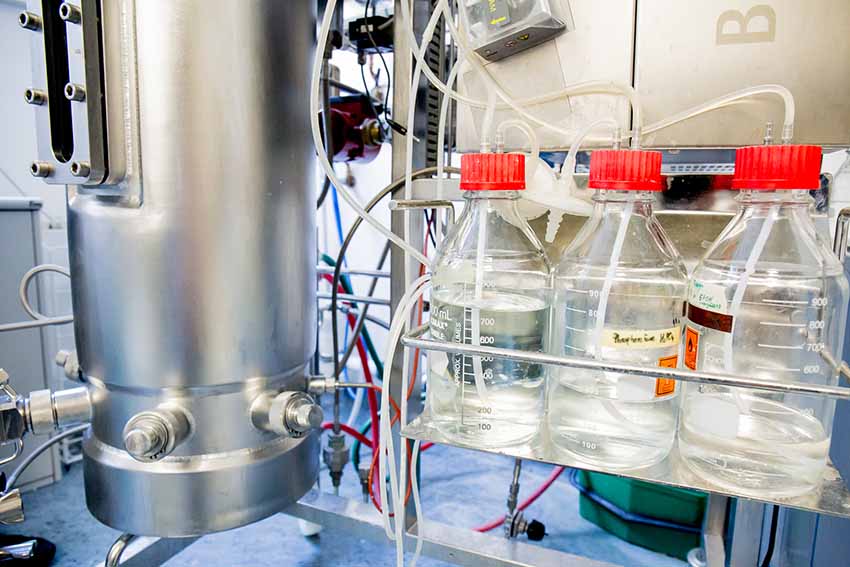Enzymicals is a leading German specialist in the field of white biotechnology with more than a decade of experience. Their mission is to create breakthrough bio-based solutions for the chemical and pharmaceutical industry and to be the specialist for implementing cost-efficient enzymatic processes for sustainable production. For achieving this, the company supports the global industry with technologies, products and offerings for the implementation of biocatalysis.
Interview with Dr. Erik de Vries, CEO of Enzymicals.
Easy Engineering: Which are the fields of activity where you are operating?
Erik de Vries: We are operating in the field of industrial biocatalysis, which is a combination of chemical and biological engineering. We do diverse activities for our internal development pipeline or high-level contract research for our clients. Typically, we are demonstrating a path to success in feasibility studies, supporting all upstream and downstream process optimizations in the viability phase, ensure predictable process reproducibility and robustness within the proof of process stage and end with scale-up actions for pilot manufacturing or to support technology transfer to full commercial scale. Summarized, we offer to go from mg to ton scale.
E.E: Which are the most significant projects from 2022?
E.d.V: Most significant for us in 2022 were several projects, all with their own significant impact. We have worked on the expression of a therapeutic enzyme in tailor-made yeast systems with freedom to operate for our client, enabling the commercial supply of diagnostic enzymes to one of the most renowned players in this field. We have also demonstrated an innovative hydroxylation reaction with an engineered unspecific peroxidase to multi g-scale, performed design of experimentation-based process optimization for an oxidase reaction to synthesize an established flavor compound, conducted proof of concept studies for diverse transaminase reactions as well as supporting the commercial production of an in-house developed imine reductase at ton scale. In addition to these commercial projects, we are working as a consortium member in EU projects on technologies for the enzymatic degradation of plastics and innovative technologies for enzymatic membrane reactors.

E.E: What projects were the most challenging?
E.d.V: We are used to accepting challenges and facing them professionally. It is the nature of our business for customers to come to us with difficult problems. The easy ones, they can solve by themselves! We are currently dealing with difficult-to-express and unstable enzymes which need to be characterized in high detail in a biochemistry project. It is always important to have the overall goal in mind and to look for pragmatic solutions together with the customer, sometimes making acceptable compromises.
E.E: What are the usual challenges you encounter?
E.d.V: Thinking on the commercial use of enzyme technology, it is first and foremost the economic benefit that allows industrial use. Here it is important to first analyze the individual cost contribution and bring this into harmony with the respective value addition. And of course, meeting the strict and sometimes optimistic timelines that our customers present to us!
E.E: How did you overcome the challenges?
E.d.V: As is usual in science, we break the problem down into parts and look at them in detail. The most significant barrier is solved first and then we proceed step by step until the whole problem is overcome. When we are faced with challenges that we cannot address on our own, we often partner with specialized technology providers. Just recently we have formed the Enzyme Technology Alliance with technologically complementary SMEs. This enables every member of the alliance to overcome the recent and future challenges as well as to increase our success rates in catalyst screening, enzyme evolution, protein immobilization and process optimization to implement competitive manufacturing processes. And indeed, there are some cases where the desired economic process metrics are impossible to reach. But even here, a well-founded rejection is an important statement.

E.E: Which are the most innovative products/solutions in your lineup?
E.d.V: Innovation comes in many shapes and forms. We would consider our progress with enzymatic membrane reactors and our intellectual property on in-situ product crystallization technology as really innovative. These approaches broaden the application potential of biocatalysis in general. Beside this we’re convinced that our recent enzyme cascades with P450 and ATAs and peroxygenase catalyzed hydroxylations are at the forefront of science in our industry.
E.E: What was the research behind the products/solutions?
E.d.V: As innovation does not necessarily proceed linearly from scientific research to product development and it is an iterative process of both matching market needs to technological
capabilities and conducting research to fill gaps in knowledge, we’re happy to have publicly funded support. We are proud to name the EU-project MACBETH and upPE-T as well as the BMBF founded project ComBioCrist as innovation drivers.
E.E: What products / solutions were used in the projects?
E.d.V: Most of our solutions are derived from a decades long experience with biocatalysis and the implementation of such processes. Maybe the key to our success is the ability to find new tools and then to properly apply them – it can never be tracked back to just one product, or one technology.

E.E: Why did the clients choose your products / solutions?
E.d.V: We are very specialized in our field with more than a decade of experience and have created our own niche in scale-up of enzymatic processes. Enzymicals’ business model is not based on the fact that we only work with own catalysts but that we are free to use third party enzyme panels in our projects. Our clients very much like to see an independent evaluation study covering the entire current commercially available catalyst landscape. Having the experience from diverse R&D programs and successful market implementations, our key personnel have unique wealth of experience and can well support the big picture. That is why they like to come back several times and build long time relationships.

